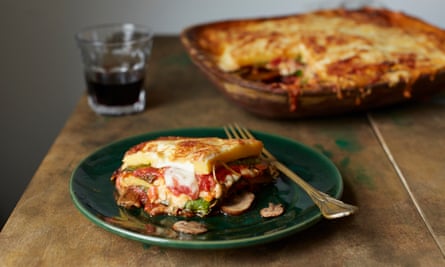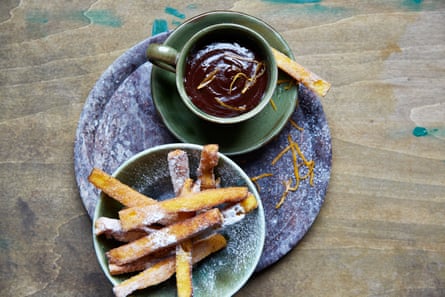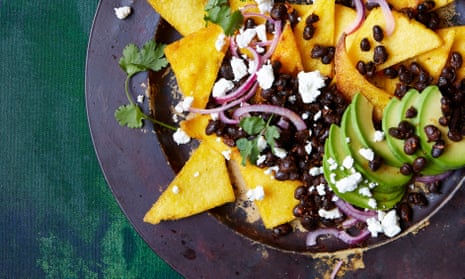As with many great foods, polenta has its fair share of detractors. Surely, these are the people who’ve never tried polenta at its silky-smooth, deeply flavoured, comforting best ...
Having a simple polenta recipe in your armoury is a route to untold riches. Make a whole packet and enjoy some fresh as a substitute for your usual mashed potatoes, rice or pasta, then leave the rest to cool into a firm block. From there, the options are endless.
To make the polenta
Makes 1.8kg
1.75 litres water
1 tbsp sea salt
1 x 400g packet coarse polenta or cornmeal
Salt and black pepper
150g butter (optional)
75-100g parmesan, grated (optional)
Olive oil, to grease
Butter and parmesan if you’re going to eat immediately
1 Pour the polenta in a slow, steady stream into a deep pan of boiling salted water, whisking continuously to prevent lumps. Keep stirring for a couple of 2 minutes until you can begin to feel it thicken.
2 Turn down to a simmer, and give it a good stir it every 5 minutes, making sure you scrape the bottom so it doesn’t stick. You may want to wrap your hand in a tea towel so it doesn’t bubble up and burn you.
3 After 35-45 minutes, the polenta should come away from the sides of the pan and taste completely tender. Season generously with salt and pepper.
4 If serving immediately, stir in the butter and parmesan and serve with a huge stew (this amount will serve 12-14). To make our batch recipes, grease a medium baking dish (22 x 28cm x 2cm) with oil, pour in the wet polenta and smooth the top. Leave to cool completely before slicing.
The punchy snack: Fried polenta nachos with black beans, pickled red onions, avocado and feta (pictured above)
Dare we say these fried polenta strips are better than the tortilla chips they replace in this dish? Crisp edges and a warm, soft centre make them the perfect vehicle for getting beans and avocado from plate to face.
Serves 4
5 tbsp olive oil
1 garlic clove, finely chopped
1 tsp cumin seeds
1 tsp smoked sweet paprika
400g tin black beans, drained and rinsed
400g polenta, at room temperature
1 ripe avocado, sliced
75g feta, crumbled
A handful of coriander leaves, to serve
Quick pickled red onion
½ red onion, finely sliced
Juice of 2 limes
Salt
1 To make the pickle, place the onion in a bowl with lime juice and salt and mix well. Set aside.
2 Heat 2 tbsp of oil in a pan over a medium-low heat and fry the garlic, cumin and paprika until the garlic begins to feel sticky and spices smell fragrantfor 1 minute. Stir in the beans, add a big splash of water and season. Cook for 10 minutes until soft.
3 When you’re ready to eat, slice the polenta into 5mm-thick, large, tortilla chip shapes. Heat 3 tbsp of olive oil in a frying pan over a medium-high heat. Fry the polenta for 2 minutes per side, until just beginning to crisp up (do not overcrowd the pan, you may need to do this in batches). Drain on kitchen paper.
4 Place on a plate, season, then top with the warm black the beans, avocado slices, feta, pickled onion and coriander leaves.
The meat-free main: vegetable polenta lasagne
This dish gives you the illusion of having made a lasagne with homemade pasta without any of the fuss.

Serves 6-8
25g dried porcini, broken up a little
For the tomato sauce
2 garlic cloves, thinly sliced
2 tbsp olive oil
2 x 400g tin plum tomatoes, drained and rinsed
For the mushrooms
300g seasonal mushrooms, sliced
2 garlic cloves, thinly sliced
2 tbsp olive oil
3 sprigs of thyme, leaves picked
For the bechamel sauce
1 litre whole milk
2 bay leaves
100g unsalted butter
100g plain flour
¼ nutmeg, grated
To assemble
100g spinach leaves, washed
150g grated parmesan
800g polenta, cut into 5mm-thick slices
A drizzle of olive oil
1 Soak the porcini in boiling water and put to one side while you make the fillings for your lasagne.
2 Fry the garlic in the oil over a medium heat until it starts to colour. Add the tomatoes, breaking them up with a wooden spoon, and season. Simmer for 25-30 minutes until a deep, rich colour.
3 Meanwhile, over a medium-high heat, fry the mushrooms and garlic in the oil for 2-3 minutes, stirring occasionally, until the mushrooms have started to colour and the garlic soften. Squeeze the water out of the soaked porcini, then add to the mushrooms along with the thyme. Cook for a few more minutes until the mushrooms are cooked through, then season to taste.
4 Set the oven to 180C/350F/gas mark 4. To make the bechamel, bring the milk to the boil with the bay, then take off the heat. In a fresh pan, melt the butter over a medium heat and stir in the flour. Cook for 3 minutes, stirring, then gradually whisk in the warm milk. Cook over a low heat for a 2 minutes, discard the bay and season with nutmeg and a little salt and pepper. Keep warm.
5 In a medium-size lasagne dish, layer with half the mushrooms, half the tomato sauce, half the spinach, half the polenta, half the bechamel and half the parmesan. Repeat, then drizzle with a little oil. Place in the oven for 25-30 minutes, until golden.
The polenta pud: Cinnamon churros with warm chocolate and orange sauce
Polenta’s slight sweetness lends itself beautifully to desserts. We often use it instead of flour when baking cakes. Here, we’re giving it the churros treatment, served alongside a bowl of a warm chocolate sauce.

Serves 4
250g polenta, at room temperature
50g butter
1 tbsp olive oil
50g icing sugar
½ tsp ground cinnamon
For the sauce
200g chocolate (70% cocoa), broken up
70g soft brown sugar
100ml double cream
40ml boiling water
A splash of Cointreau (optional)
Zest of 1 orange
1 For the sauce, put the chocolate, sugar, cream and water in a heavy-based pan over a low heat, stirring, until melted. Remove from heat, then stir in the Cointreau if using, (if using) and the orange zest, and keep warm.
2 Cut the polenta into batons, roughly 8 x 1 x 1cm. In a large frying pan over a medium-high heat, melt the butter with the oil until foaming. Fry the polenta in batches, making sure to cook each side until brown and crisp, then and drain on kitchen paper and keep warm in a low oven.
3 Mix the icing sugar and cinnamon, then dust over the polenta. Serve with the warm chocolate sauce for everyone to help themselves.
The quick supper: Polenta pizza with radicchio and black olives
An ingenious way to use the last of the polenta. Anything you have would work here, but we love the bitterness of radicchio combined with the saltiness of olives and creamy ricotta. Serve with a few slices of prosciutto to make this a bit more substantial.
Serves 4
350g polenta
100ml boiling water
2 tbsp olive oil
1 sprig rosemary, leaves picked
75g grated parmesan
125g ricotta
1 egg yolk
½ head radicchio or other bitter leaf, shredded
2 tbsp black olives, roughly chopped
1 tbsp toasted pine nuts
½ tbsp sherry or red wine vinegar
1 Preheat the oven to 200C/400F/gas mark 6. Crumble the polenta into a saucepan, add 100ml of boiling water, put over a medium heat and whisk constantly until the polenta is completely smooth.
2 Put an ovenproof frying pan over a medium-high heat, and when hot, add 1 tbsp of olive oil and the rosemary leaves. Let them crackle for a few moments before adding the polenta. Be careful as the oil spit a little. Help the polenta settle into an even layer with the back of a spoon. Fry for a couple of minutes to allow the base to set.
3 After 2-3 minutes, sprinkle over 50g of parmesan and put in the oven for 15-20 minutes until set and beginning to colour. Meanwhile, combine the remaining parmesan with the ricotta and egg yolk and season well.
4 Remove the polenta from the oven and dot with spoonfuls of the ricotta mix. Return to the oven for a further 10 minutes.
5 Meanwhile, combine the radicchio, black olives and pine nuts and dress with the remaining 1 tbsp of olive oil, the vinegar and a little seasoning.
6 Remove the polenta from the oven and slide it out on to a plate to cool a little. Slice it, then pile the radicchio-olive mix on top. Serve immediately.

Comments (…)
Sign in or create your Guardian account to join the discussion